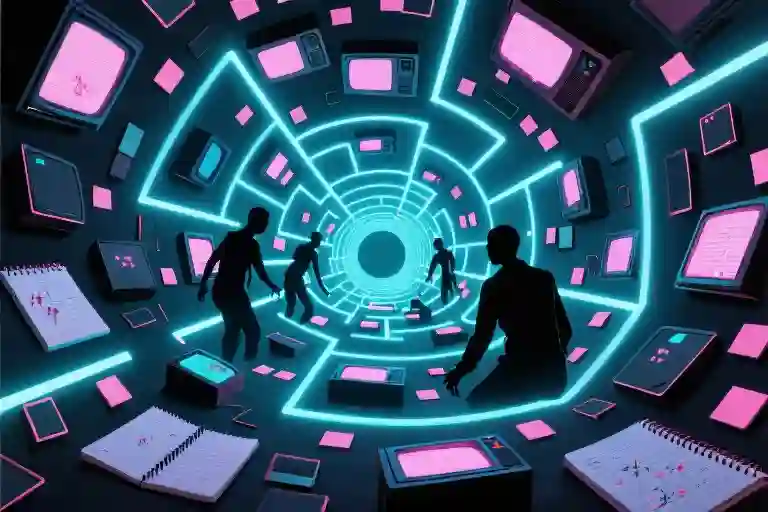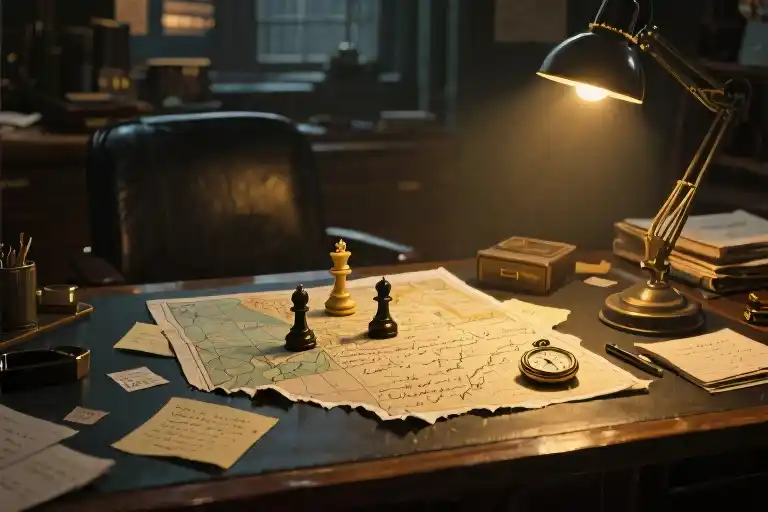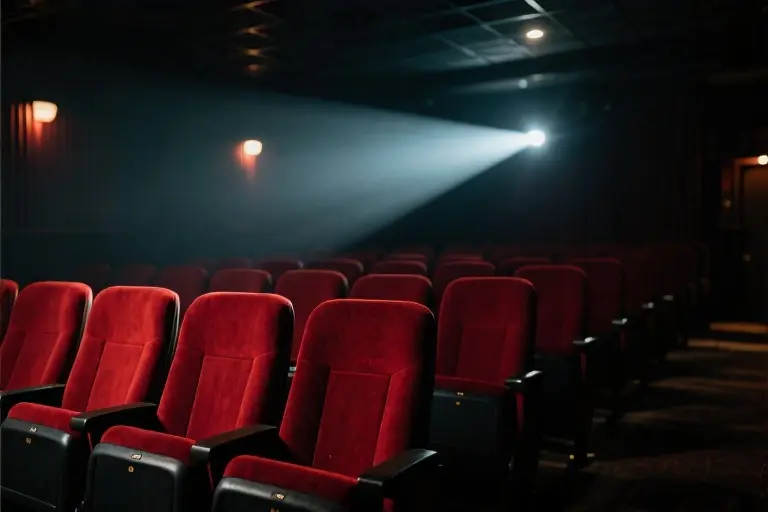The glow of laptop screens at 3 AM illuminates hastily drawn family trees and intersecting timelines. On Reddit threads, users debate whether the pocketwatch in episode 4 was a Chekhov’s gun or a red herring. This peculiar modern ritual accompanies every great mind-bending story – the kind that makes you question reality long after the credits roll.
What strange alchemy turns confusion into addiction? Why do we relish stories that demand spreadsheet analysis to comprehend? Adam Scott’s candid confession about filming Severance captures this paradox perfectly: “We felt it was really weird and had no idea if it would connect with anybody… what if people think it’s stupid and weird?” That creative anxiety birthed one of television’s most discussed puzzle boxes.
The best mind-bender narratives operate like literary Möbius strips – surfaces that twist back on themselves, revealing new dimensions with each examination. They don’t simply withhold answers; they redesign the questions. When Dark introduced its generational time loop or when Severance bifurcated consciousness between work and personal selves, they weren’t just telling stories – they were issuing intellectual invitations.
This compulsive engagement manifests physically. Notebooks fill with theories about Westworld’s maze. Kitchen walls become incident rooms for True Detective’s occult symbols. The very difficulty becomes the draw – not unlike crossword enthusiasts who measure satisfaction by grid complexity. There’s neurological evidence behind this phenomenon: MRI scans show puzzle-solving triggers dopamine release similar to musical frisson or mathematical epiphanies.
Modern audiences don’t want passive consumption; they crave participatory storytelling. The rise of “Ending Explained” YouTube channels (averaging 2-3M views per major mind-bender finale) proves completion isn’t the goal – the communal deciphering process is. Like archaeologists piecing together fragments, we derive pleasure from collaborative meaning-making. Severance’s 136% increase in Parrot Analytics demand after its finale suggests viewers weren’t satisfied – they were activated.
Perhaps this explains why traditional mystery structures feel increasingly inadequate. Agatha Christie’s neatly packaged resolutions can’t compete with the lingering unease of shows that leave certain doors intentionally ajar. The contemporary mind-bender doesn’t tie knots – it creates labyrinths where getting lost is the destination. In an age of algorithmic predictability, genuine narrative disorientation has become the ultimate luxury experience.
The Paradox of High-Risk Storytelling: From Self-Doubt to Acclaim
There’s a peculiar alchemy that happens when creators dare to venture into narrative territories so strange they question their own sanity. Adam Scott’s confession about filming Severance captures this perfectly: that gnawing fear your brilliant weirdness might just be… well, stupid weirdness. Yet history shows us repeatedly that the stories which terrify their makers the most often become the ones we can’t stop dissecting.
When Creators Become Their First Skeptics
The Severance team’s experience mirrors Christopher Nolan’s early struggles with Inception. Warner Bros initially passed on the project, with executives openly questioning whether audiences would follow its dream-within-a-dream architecture. Nolan himself admitted keeping a ‘confusion meter’ during test screenings, watching for the exact moment viewers’ brows furrowed too deeply. This creative vertigo – the sensation of potentially losing your audience in the labyrinth you’ve built – appears to be a rite of passage for mind-bending narratives.
Neuroscience offers an explanation for why these gambles pay off. When confronted with controlled cognitive dissonance – that delicious tension between confusion and comprehension – our brains release dopamine upon solving narrative puzzles. It’s the same reward system that makes crossword puzzles addictive, amplified by emotional investment in characters. The Severance writers exploited this brilliantly by grounding their bizarre corporate dystopia in Ben Stiller’s direction – all sterile whites and muted performances that made the weirdness feel uncomfortably plausible.
The Fine Line Between Genius and Gibberish
What separates triumphant mind-benders from self-indulgent messes often comes down to three invisible guardrails:
- Architectural Precision: For all their seeming chaos, works like Dark operate with Swiss-watch mechanics. Every apparent plot hole in its time-twisting narrative had pre-planned resolutions across seasons.
- Emotional Anchors: Everything Everywhere All At Once could have been sensory overload, but the immigrant family drama kept audiences oriented amidst the multiversal madness.
- Reward Scheduling: Successful examples drip-feed revelations at intervals that match human attention spans – about every 22 minutes for TV, aligning with our natural restlessness cycles.
This delicate balance explains why so many Severance fans found themselves compulsively whiteboarding theories between episodes. The show provided just enough clarity to feel solvable, while withholding enough to sustain mystery. Like a magician who shows you half the trick, it invites participation rather than passive viewing.
The Uncomfortable Truth About Originality
Perhaps the most comforting lesson for creators lies in the consistent pattern of initial resistance. From Twin Peaks being dismissed as ‘that weird soap opera’ to Rick and Morty’s pitch being rejected as ‘too cerebral for animation,’ breakthrough mind-benders almost universally faced early skepticism. There’s an important distinction here between willful obscurity and challenging storytelling – the former loses audiences, while the latter rewards their investment with richer payoffs.
As streaming platforms develop algorithms to predict ‘weirdness tolerance thresholds’ in their audiences, we’re seeing more studios embrace calculated risks. The surprise success of Severance may mark a turning point where unconventional narratives move from niche to mainstream – provided they remember to build handrails along their narrative cliffs.
The Three Core Codes of Mind-Bender Storytelling
What separates a forgettable puzzle from a story that lingers in your frontal cortex for weeks? The best mind-bending narratives don’t just confuse audiences—they weaponize confusion through deliberate design. After analyzing dozens of genre-defining works, three structural patterns emerge as non-negotiable elements.
Controlled Chaos: The Art of Calculated Confusion
Christopher Nolan’s Tenet didn’t just play with time inversion—it built an entire action sequence around a bullet returning to its gun. This exemplifies the first rule: audiences will tolerate immense complexity if you establish clear ‘rules of engagement.’ The key lies in creating self-contained logic systems that feel discoverable, even when they defy physics.
Successful mind-benders operate like escape rooms. Dark gave viewers the family tree tool as a compass; Primer provided just enough technobabble about ‘the box’ to make its time loops feel plausible. The moment this balance tips into true incomprehensibility (looking at you, Southland Tales), you lose the audience’s trust along with their interest.
Metaphor Overload: Symbolism as a Second Language
Alex Garland’s Annihilation didn’t need dialogue to explain its mutated bear—the creature’s haunting mimicry of human screams became the film’s most discussed element. Great mind-benders layer their stories with visual and thematic symbolism that bypasses rational understanding to hit primal nerves.
Consider how color gradients in Beyond the Black Rainbow map emotional states, or how Severance uses corporate jargon as psychological warfare. These aren’t Easter eggs for Reddit threads (though they spawn them)—they’re emotional cheat codes that resonate subconsciously. When the Wachowskis had Neo choose between red and blue pills, they embedded the entire film’s philosophy in a single visual metaphor.
Community Participation: The Crowdsourced Payoff
Here’s where Emily in Paris serves as the perfect anti-example. No one stays up debating the deeper meaning of Emily’s Instagram posts because the show offers no interpretative depth. Contrast this with Westworld season one, where fans collectively piecing together the timeline became half the fun.
The modern mind-bender doesn’t end at the credits—it migrates to YouTube explainers, podcast breakdowns, and Twitter threads. Disco Elysium didn’t just allow player choice; it encouraged communities to compare radically different playthroughs. This participatory element transforms passive viewers into active investigators, creating the narrative equivalent of a group project everyone actually wants to finish.
What unites these codes is their demand for audience investment. Unlike traditional stories that hand you meaning, mind-benders make you feel like you’ve stolen it—and that stolen knowledge always tastes sweeter.
When Mind-Bending Stories Conquer New Mediums
The most fascinating evolution of complex narratives isn’t happening on traditional screens anymore. That tingling sensation you get from untangling a narrative puzzle? It’s now creeping into spaces we never expected – through VR headsets, mobile games, and even 15-second video clips. The DNA of mind-bender storytelling has broken containment.
Take Meta’s experimental VR film The Line. At first glance, it’s a charming period piece about miniature characters in 1940s São Paulo. But the moment you lean closer (literally – the medium demands physical engagement), you realize every object holds layered meanings. The teacup isn’t just a teacup; it’s a timestamp. The phonograph isn’t background decor; it’s a narrative reset button. This is Severance‘s corporate surrealism reimagined for immersive media, where environmental details become the primary storytelling language. Unlike passive viewing, the format forces you to piece together the mystery by moving through space, turning audience members into active archeologists of meaning.
Then there’s Twelve Minutes, the anxiety-inducing time loop game that makes Groundhog Day look straightforward. Its genius lies in how it weaponizes interactivity against the player. You’ll spend hours replaying the same 12-minute segment, each iteration revealing new variables: that unlocked drawer matters only if you watered the plant three loops ago. The game designer Luis Antonio once described it as “Dark meets point-and-click adventure,” but that undersells its brilliance. Traditional mind-bender films allow rewatching; this game demands it, baking the frustration of incomplete understanding directly into the mechanics. Your controller becomes a detective’s notebook.
Perhaps most surprising is TikTok’s #PuzzleTheory phenomenon. Creators like @chrono.narratives have mastered the art of micro-complexity, packing Inception-level twists into vertical videos shorter than toothpaste commercials. One particularly viral sequence used:
- 00:03: A woman checks her fridge (normal)
- 00:07: The same shot repeats with one added item (milk carton)
- 00:11: Third repeat shows the carton’s expiration date: 1987
- 00:15: Final frame reveals her reflection isn’t moving
These aren’t just compressed stories; they’re narrative landmines designed to detonate in group chats. The comment sections explode with theories, each reply adding to the collective decoding – proof that mind-benders thrive when social participation is frictionless. What used to require Reddit threads now happens in real-time through duet reactions.
What unites these experiments? They all exploit their medium’s unique affordances to intensify the core mind-bender experience. VR makes confusion spatial. Games make it tactile. Social video makes it communal. As these formats converge (imagine a Bandersnatch-style narrative where crowd-sourced theories alter the next episode), we’re witnessing the democratization of narrative complexity. The puzzles are no longer just to solve – they’re to inhabit, manipulate, and ultimately, co-create.
Closing Thoughts: The Value of Not Understanding
There’s something strangely liberating about admitting you don’t fully grasp what you just watched. That moment when the credits roll on a particularly dense episode of Severance or Dark, and you find yourself staring blankly at the screen – not frustrated, but intrigued. The kind of confusion that doesn’t push you away, but pulls you deeper in.
This might be the most counterintuitive truth about mind-bending stories: their value often lies in what they don’t explain. When Adam Scott admitted the Severance team worried their show might be “too weird,” they were tapping into that creative sweet spot where uncertainty becomes an asset rather than a liability. The audience’s need to piece together timelines, decode symbolism, and debate theories transforms passive viewing into active participation.
Consider how you engage with these stories. Pausing to rewatch scenes, sketching relationship diagrams on notebook margins, falling down Reddit rabbit holes at 2am – these aren’t signs of frustration, but of a narrative successfully doing its job. The best mind-benders create just enough confusion to be tantalizing, but not so much as to be alienating. They walk that delicate line between mystery and clarity where the most compelling discussions are born.
So when we ask “how much ‘not understanding’ is worth to you?” we’re really asking about your tolerance for creative risk. Every confusing moment in Inception or ambiguous ending in Arrival represents someone’s leap of faith – the writers trusting the audience will meet them halfway. Your willingness to sit with that discomfort directly fuels more daring storytelling.
Which mind-bender left you deliciously bewildered? Share your pick below – maybe it’s Primer’s time loops that broke your brain, or The Leftovers’ emotional puzzles that stayed with you for weeks. And stay tuned for our deep dive into 1899’s untimely cancellation – sometimes the most fascinating mysteries happen behind the scenes.
Because here’s the secret no algorithm will tell you: in an age of endless content, being memorable matters more than being immediately understandable. The stories we can’t stop puzzling over are the ones we never really leave behind.





